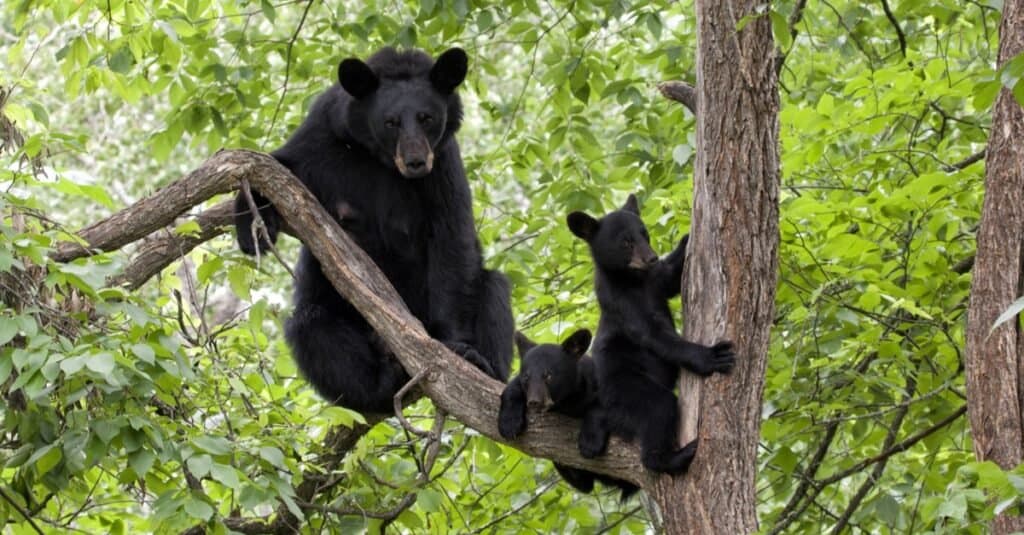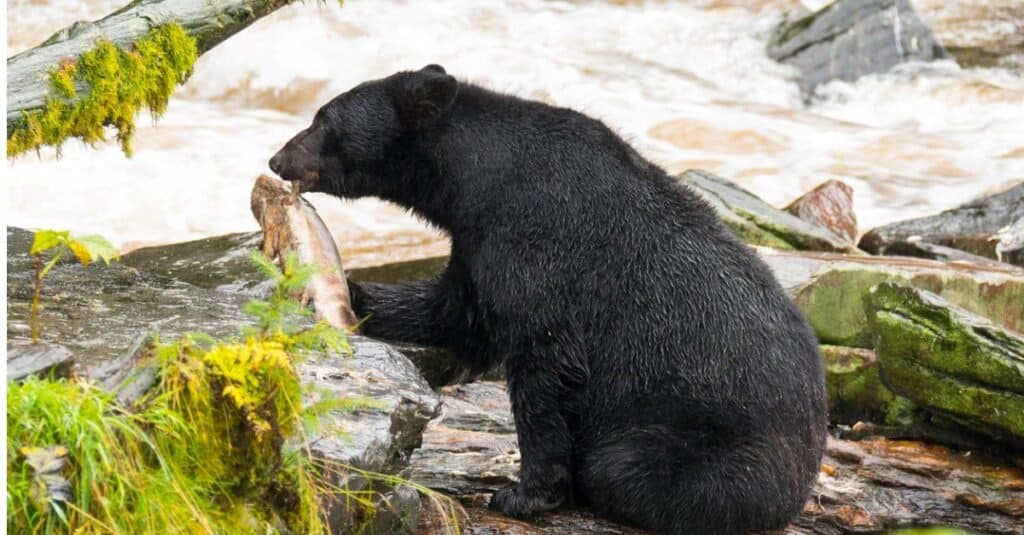The first thing you may notice about an adult black bear is its tremendous size. Though it’s not the largest species, an adult black bear is still bigger than most humans. However, it is a human is more likely to encounter adolescent bears as they tend to travel around more. Which brings up the question: Are black bears aggressive? The answer may surprise you.
Find out what to do in the event of a black bear attack and discover reasons why this animal may become aggressive. Also, check out a few misconceptions about these animals.
Are Black Bears Aggressive?
No. These are shy animals that prefer to stay away from people. Of course, there are times when humans come in contact with this animal. People who hike or camp in wooded areas may encounter black bears. However, these animals don’t show aggression unless there is a reason. They aren’t dangerous to humans unless provoked.
What Causes Aggression in Black Bears?
A female black bear may become aggressive if a person approaches her cubs or tries to touch them. Like many other animals, they are very protective of their young. Though the person may not mean any harm to the cubs, the female will likely feel threatened and become aggressive.
There’s potential for aggression when this animal is caught off guard. For instance, a person jogging in the woods turns a corner on the trail and sees a black bear digging in a pile of leaves. The animal is startled by the person’s sudden appearance. This could cause it to show aggression thinking the person is a threat.
The season can also affect the behavior of these animals. This bear is an omnivore. In the late summer and early fall seasons it eats all of the fish, insects, plants, and animal meat it can find. It is trying to gain extra fat so it will survive hibernation through the winter. It’s a matter of life and death. So, anything that distracts or prevents them from consuming food is likely to bring out aggression. Keep in mind there are a lot of people out hiking and camping in late summer and early fall. This increases the chances of encounters between humans and black bears.
This animal can become aggressive when someone tries to take its food. This is true any season of the year! These animals have an excellent sense of smell. This is how they find campsites where people leave food out. A camper who tries to take their food away from a black bear is very likely to be considered a threat and met with aggression.

©Debbie Steinhausser/Shutterstock.com
What to Do If You Encounter a Black Bear?
The main thing to remember when hiking or camping in the woods is to always be aware of your surroundings. Avoiding this animal is the best way for you to maintain your safety. So, if you see a bear off in the distance, you know to stop and head in the other direction before you are seen. Fortunately, if you happen to encounter a black bear, the experts at the National Park Service have offered some guidance on what to do.
First, it’s important to stay calm. Talk to the animal in a calm voice to let it know you are not a threat.
Next, determine whether the black bear is making a bluff charge or a real one. This animal may make a bluff charge as a warning. When making a bluff charge the animal holds its head up and points its ears forward. It makes a sudden move toward you but stops just short of where you’re standing. An animal that makes a bluff charge is trying to scare you away. Not surprisingly, this is an effective tactic!
Talk to the animal while slowly backing away. Wave your arms as a way to take up more space and appear bigger. Appearing bigger may discourage the animal from making another bluff charge.
Don’t run. Running is a signal to the bear that the chase is on. Black bears can run at a speed of 40mph. Not only are they faster than humans, but their short claws also make them experts at climbing trees.
While some animals make a bluff charge, others do the real thing. A black bear that’s about to charge puts its head down and ears back. Sometimes they yawn or hit their teeth together. These are all aggressive signs. The animal is literally showing you its teeth. If this happens, try to remain calm and stand still. When a black bear charges it hits whatever is in front of it with tremendous force. Use your fists, feet, rocks, or whatever else you can to drive the bear away.
Some people carry bear spray as a safety precaution. Bear spray is kind of like mace. If sprayed in a bear’s face it temporarily stings their eyes making it hard to see. This substance also affects a bear’s breathing. These reactions are all temporary and designed to give a person enough time to get out of the area safely. Bear spray causes no permanent damage to the bear. Once again, you shouldn’t run even if the animal displays signs that it’s going to charge.
What Are Some Precautions to Take in Bear Country?
When hiking or camping in an area where black bears live, it’s important to take the guidance of park rangers. They are familiar with the terrain and know where these animals are likely to go. In addition, many parks put up signs indicating the presence of a bear den, cave, or a feeding place nearby. This is not an invitation to explore the area; it’s a warning to move to another location.
A second precaution is to keep garbage wrapped up and secured so it can be disposed of in a safe place. These animals have an excellent sense of smell, so it’s best to avoid tempting them with the aroma of food. Some park rangers even advise people to change clothes after cooking a meal. Sometimes the aroma of food can linger in clothing material.
Staying on the trail is another precaution to take. These animals are likely to avoid well-traveled trails. As mentioned, they prefer to stay clear of humans. Wandering off-trail means visitors to the woods are more likely to encounter a bear.
What Are Some Common Misconceptions About Black Bears?
One misconception about this animal is that it can sense fear. Furthermore, this makes it especially dangerous to humans. Who wouldn’t be scared upon seeing this huge creature? However, black bears don’t attack because they sense fear. It’s the behavior of the person that factors into whether the animal becomes aggressive.
A second misconception is that giving black bears food is a good way to make friends with them. For instance, someone may try to leave plates of food out on the porch, in the garden, or in the yard. But, black bears are wild animals, not pets. It may seem like a fun idea to put out food for them, but they can become aggressive especially when food is involved. Feeding bears will only encourage to return again and again. Plus, human food is not good for the health of this omnivore.
Where Do Black Bears Live?
Black bears live in densely forested areas. They are a feature at many national parks in the United States. Some examples include the Great Smoky Mountains National Park, Rocky Mountain National Park, and Yellowstone National Park.

©iStock.com/ElliotHurwitt
How Big Are Black Bears?
Black bears can measure five to six feet in length and weigh 200 to 600 pounds. Generally, males are larger than females. These are powerful animals with sharp claws and teeth.
What Time of Year Are These Animals Active?
They are most active in the spring and summer. These animals come out of hibernation sometime in April and go back into hibernation usually in the month of October. They have their cubs sometime between December and February. So, springtime is when mothers and cubs are especially active.
Is There a Different Way to React to Aggression from Other Types of Bears?
Yes. When a person encounters a black bear, it’s best to talk calmly, avoid looking it in the eye, and move slowly away. It’s a different story with another omnivore, namely, the grizzly bear. These animals can be very dangerous to humans.
In the event of a grizzly attack, experts at the National Park Service advise you to ‘play dead.’ Remain still on the ground, don’t make any noise, and wait until the grizzly is out of the vicinity before trying to move away. This is the exact opposite of what to do when dealing with a black bear.
Both species are large and powerful. This makes it all the more important to have respect for these animals, their young, and their habitat. A person can practice safety and still enjoy the same wooded surroundings as these animals.
Up Next…
- North American Black Bear Click here to learn more about these shy forest dwellers.
- Black Bear Population by State Are you planning a trip. Check out this article to find out where you are most likely to encounter a black bear.
- The Largest Black Bear in History Black bear are not the largest bear in the woods but they can get quite large. Check out the record holder here.
The photo featured at the top of this post is © BGSmith/Shutterstock.com
Thank you for reading! Have some feedback for us? Contact the AZ Animals editorial team.







